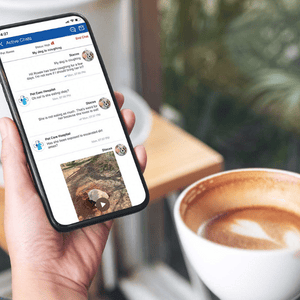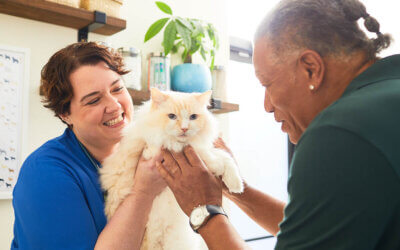Picture this: It’s 8:30 a.m. on a Tuesday. Your veterinary practice team is busy checking patients in for procedures, answering emails, and calling clients who left voicemails overnight. The phone is ringing off the hook with clients trying to get their pet in for a same-day appointment because their pet has been vomiting for two days or they’ve noticed some weird lump or bump.
Other clients are calling because they can’t remember exactly how they were supposed to administer those eye drops, or they forgot what the veterinarian said when they picked up their newly neutered pet yesterday.
The day has barely begun, and everyone on your team is already tired. Plus, the veterinary clients sitting on hold are lamenting your less-than-stellar service.
Now, picture this: It’s 8:30 a.m. on a Tuesday. Your digital coordinator is answering emails, calling clients who left voicemails overnight, and fielding incoming chats and text messages from clients.
With the phones not ringing off the hook, your front-desk team is free to field check-in forms and quickly get patients checked in for their procedures and wellness visits.
The day is in full swing and everyone is efficiently and happily working together. It’s like a well-oiled machine, and each client feels like they are at the center of it — like their needs are all that matter to your team.
Veterinary client communication doesn’t have to leave your team feeling exhausted, or leave your clients feeling frustrated and unimportant. You can give every client the VIP treatment. And, what’s the best part? Your team can actually feel less stress while doing it.
Why you need to offer clients easy ways to reach your veterinary practice
When I say “easy ways,” I’m not referring to the telephone. Obviously you shouldn’t get rid of your telephone — it’s still an important method of communication. But, if you haven’t incorporated chatting and texting into your communication toolbox, it’s definitely time to remedy that.
Why? Here are four reasons.
1. Millennials — the largest pet owning generation — do not like talking on the phone
Millennials (born between 1981 and 1996) and Gen Z (born between 1996 and 2015) have been called the “post-phone call generations.” These generations find phone calls to be rude and anxiety-inducing.
A BankMyCell study found:
- 75% of millennials avoid phone calls because they are time-consuming and disruptive.
- 81% of millennials get apprehension anxiety before making a phone call.
Research from the Center for Generational Kinetics found that millennials prefer texting apps, and another study revealed that 77% of respondents use the native texting apps on their phones.
Many clients feel like it’s a “bother” to call your practice if they have a quick question about their pet’s health. Allowing them to send a chat or text feels less intrusive to them, and it greatly improves the veterinary client experience and grows the bond they have with your practice.
2. Phone calls are usually less efficient than other communication methods
Picture this: You’re talking on the phone with your best friend from college. It’s great catching up. Then, your phone beeps, indicating another call is coming in. It’s from your kid’s school. “Shoot, I need to answer that,” you tell your friend. “Hold on.”
It’s the school’s automated messenger reminding you about the field trip on Friday. You hang up in frustration. “Why couldn’t they just send an email or text about that?” you say to your friend when you return to the call.
Well, they could have. And if they did, you could have handled two things at the same time, reading the quick text from the school while listening to your friend as she reminisced about the good ol’ days.
One person can only handle one phone call at a time.
But, one person can handle multiple chats or text messages at the same time. That’s why — in the scenario I brought up in the first part of this article — your digital coordinator was able to field multiple incoming chats and texts with ease.
Unless your communication requires a serious or complicated discussion — like a difficult diagnosis, it’s more efficient to communicate via text or chat.
3. You can’t refer back to phone calls
Phone calls aren’t in writing, so you can’t look back at them later if you need to. You may remember saying one thing, but your client remembers hearing something entirely different (or doesn’t remember anything you said at all).
That’s why chat, text, or email are all great ways to educate clients, and allow them to reach out to you with their questions, so they can refer to your answers later.
4. A picture is worth a thousand words
That dog you just diagnosed with diabetes? Send the owner a link to a YouTube video with instructions on how to administer insulin. That cat you just sent home after her spay? Reach out via text or chat the next day and ask the owner to send a photo of her incision.
Chats, texts, and emails allow you and your clients to send and receive photos, videos, links, and documents. These communication methods reduce miscommunication and help each party to better understand the other.
The telephone may never go away, but your veterinary clients and team are craving different communication methods. Check out how Vetsource’s client connection platform can help to elevate your practice’s client communication game — schedule a demo today.



